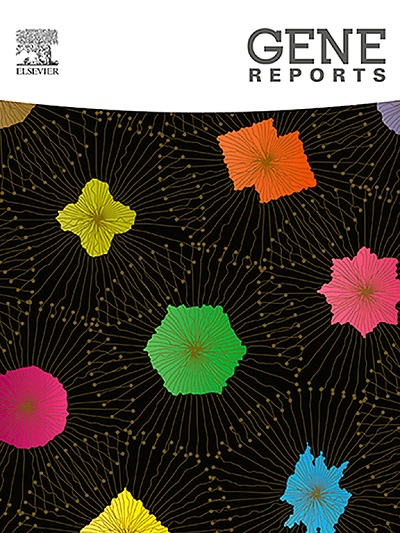Mitogenome based adaptations and phylogeny of Beetal goats in India
IF 1
Q4 GENETICS & HEREDITY
引用次数: 0
Abstract
Beetal goats, the second largest Indian goat breed, are known for their adaptation to hot arid tropical climates. Beyond their phylogenetic significance, recent evidence suggests that mitogenome modifications play a crucial role in the adaptation of animals to environmental stress factors. This study aims to characterize the mitogenome of Beetal goats at the molecular level, elucidate their mitogenomic adaptations and determine the maternal phylogenetic status of Indian Beetal goats. Whole genome sequencing of pooled DNA samples from five unrelated Beetal goats was carried out to obtain mitogenome sequence. The Beetal goat mitogenome comprised of a coding region with 37 genes: 22 transfer RNAs (tRNAs), 13 protein-coding genes (PCGs), and two ribosomal RNAs (rRNAs), as well as a non-coding hypervariable displacement loop (D-loop) region. We identified nine SNPs inclusive of seven synonymous and two nonsynonymous ones located in PCGs that too in respiratory complex I subunit genes, five of which were novel. Two nonsynonymous SNPs (10,229 A > G in ND4 and 13,964 G > A in ND6) were homoplasmic ones with marked influence on their mRNA and protein structures. Synonymous SNPs influenced the minimum free energy (MFE) and topology of predicted mRNA secondary structures, thereby affecting mRNA stability and translation efficiency. Phylogenetic analysis of the D-loop region classified Beetal goats into haplogroup B. Mitogenome analysis of Beetal goats, in comparison with other goat populations revealed the greatest genetic similarity to Southeast Asian goats. The comprehensive analysis of mitochondrial DNA in Beetal goats reveals significant genetic adaptations crucial for their survival in hot, arid environments. This study also highlights the complex matrilineal origins of Beetal goats.
印度山羊基于微基因组的适应性和系统发育
Beetal山羊是印度第二大山羊品种,以适应炎热干旱的热带气候而闻名。除了其系统发育意义之外,最近的证据表明,有丝分裂基因组的修饰在动物适应环境胁迫因素方面起着至关重要的作用。本研究旨在从分子水平描述比塔尔山羊有丝分裂基因组的特征,阐明其有丝分裂基因组的适应性,并确定印度比塔尔山羊的母系系统发育状况。对来自五只无亲缘关系的比达山羊的DNA样本进行了全基因组测序,以获得有丝分裂基因组序列。比达山羊有丝分裂基因组由一个包含 37 个基因的编码区组成:22 个转运核糖核酸(tRNA)、13 个蛋白质编码基因(PCG)和 2 个核糖体核糖核酸(rRNA),以及一个非编码超变异位移环(D-loop)区。我们发现了 9 个 SNPs,包括 7 个同义 SNPs 和 2 个非同义 SNPs,它们位于 PCGs 中的呼吸复合体 I 亚基基因中,其中 5 个是新发现的。两个非同义 SNP(ND4 中的 10,229 个 A > G 和 ND6 中的 13,964 个 G > A)是同质的,对其 mRNA 和蛋白质结构有显著影响。同义 SNP 影响了预测的 mRNA 二级结构的最小自由能(MFE)和拓扑结构,从而影响了 mRNA 的稳定性和翻译效率。与其他山羊种群相比,Beetal 山羊的线粒体基因组分析显示其与东南亚山羊的遗传相似性最大。对 Beetal 山羊线粒体 DNA 的全面分析揭示了它们在炎热、干旱环境中生存的重要遗传适应性。这项研究还突显了贝塔尔山羊复杂的母系起源。
本文章由计算机程序翻译,如有差异,请以英文原文为准。
求助全文
约1分钟内获得全文
求助全文
来源期刊

Gene Reports
Biochemistry, Genetics and Molecular Biology-Genetics
CiteScore
3.30
自引率
7.70%
发文量
246
审稿时长
49 days
期刊介绍:
Gene Reports publishes papers that focus on the regulation, expression, function and evolution of genes in all biological contexts, including all prokaryotic and eukaryotic organisms, as well as viruses. Gene Reports strives to be a very diverse journal and topics in all fields will be considered for publication. Although not limited to the following, some general topics include: DNA Organization, Replication & Evolution -Focus on genomic DNA (chromosomal organization, comparative genomics, DNA replication, DNA repair, mobile DNA, mitochondrial DNA, chloroplast DNA). Expression & Function - Focus on functional RNAs (microRNAs, tRNAs, rRNAs, mRNA splicing, alternative polyadenylation) Regulation - Focus on processes that mediate gene-read out (epigenetics, chromatin, histone code, transcription, translation, protein degradation). Cell Signaling - Focus on mechanisms that control information flow into the nucleus to control gene expression (kinase and phosphatase pathways controlled by extra-cellular ligands, Wnt, Notch, TGFbeta/BMPs, FGFs, IGFs etc.) Profiling of gene expression and genetic variation - Focus on high throughput approaches (e.g., DeepSeq, ChIP-Seq, Affymetrix microarrays, proteomics) that define gene regulatory circuitry, molecular pathways and protein/protein networks. Genetics - Focus on development in model organisms (e.g., mouse, frog, fruit fly, worm), human genetic variation, population genetics, as well as agricultural and veterinary genetics. Molecular Pathology & Regenerative Medicine - Focus on the deregulation of molecular processes in human diseases and mechanisms supporting regeneration of tissues through pluripotent or multipotent stem cells.
 求助内容:
求助内容: 应助结果提醒方式:
应助结果提醒方式:


